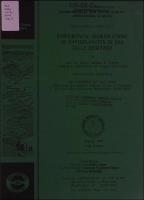Please use this identifier to cite or link to this item:
https://hdl.handle.net/11681/3008| Title: | Experimental manipulations of phytoplankton in Eau Galle Reservoir |
| Authors: | Environmental and Water Quality Operational Studies (U.S.) Barko, John W. Klemer, Andrew R. McFarland, Dwilette G. Hennington, Susan |
| Keywords: | Alum Reservoirs Nutrients Sediment Phosphorus Water quality Phytoplankton Eau Galle (Wis.) Ecology |
| Publisher: | Environmental Laboratory (U.S.) Engineer Research and Development Center (U.S.) |
| Description: | Miscellaneous Paper Abstract: Poor water quality in Eau Galle reservoir, located in west-central Wisconsin, has been associated historically with an overabundance of nuisance planktonic algae (phytoplankton) during the summer months. In an attempt to improve water quality, a variety of experiments was conducted over a 2-year period in large (10-m-diameter) enclosed water columns. Specific objectives of these experiments were to reduce phytoplankton standing crop and to promote favorable changes in speciP.s composition, i.e., away from nuisance algae (cyanophytes and dinoflagellates) towards more desirable algae (diatoms and chlorophytes). Experimental treatments, implemented singly and in combination included destratification by mixing, addition of soluble silica, sediment sealing with sand, and precipitation of phosphorus with block aluminum sulfate. Mixing, alone or in combination with silica addition, extended the presence of vernal diatom populations into the summer in one investigation. In contrast, addition of silica to the water column without mixing had no effect on diatom production. In general, mixing stimulated phytoplankton production by increasing phosphorus availability. However, phosphorus inactivation with block aluminum sulfate suspended in the water was sufficient to overcome this effect. Individual effects of phosphorus precipitation and sediment sealing were similar; both decreased phytoplankton standing crop in association with decreased total phosphorus concentrations. Since most of the phosphorus contributed to the phytoplankton in Eau Galle reservoir derives from the sediment, complexation of sediment phosphorus is recommended to improve water quality. |
| Rights: | Approved for public release; distribution is unlimited. |
| URI: | http://hdl.handle.net/11681/3008 |
| Appears in Collections: | Miscellaneous Paper |
Files in This Item:
| File | Description | Size | Format | |
|---|---|---|---|---|
| MP-E-86-4.pdf | 3.75 MB | Adobe PDF |  View/Open |